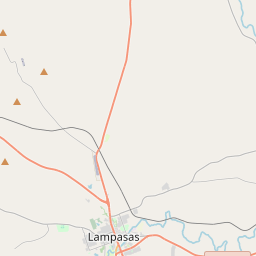Lampasas County Courthouse
Historical marker location:





Lampasas County Courthouse
After the Texas Legislature created Lampasas County in 1856, official business of the county was conducted from a variety of spaces and buildings. Land for the courthouse square was set aside when the town of Lampasas was platted in the 1850s. In 1882, the Gulf, Colorado and Santa Fe Railroad extended their tracks to the county seat, bringing significant growth and prosperity to the area.
In 1883, the Commissioners Court, with county judge W. P. Beall presiding, hired Waco architect Wesley Clark Dodson to design the new courthouse. The building contractor (Kane Brothers) and the stone contractors (T. Lovell and Company) executed Dodson's plan, completing the building in 1884. Reflecting influences of the Second Empire and Italianate styles of architecture, the Lampasas County Courthouse features a central clock tower, arched windows and a mansard roof. In 1884, the Commissioners Court authorized the city to place a Seth Thomas clock in the tower.
Since its construction, the courthouse has been a focal point for city and county activities, including local festivals. Floods in 1936 and 1957 damaged the building, requiring repair and reconstruction. Today, the stately Lampasas County Courthouse remains an outstanding example of the golden era of courthouse construction in the state. It continues to serve as an important symbol of the county's growth and development and as an influence on the historic character of the county seat.
Recorded Texas Historic Landmark - 1965
As one of the most visible programs of the Texas Historical Commission (THC), historical markers commemorate diverse topics in Texas history, including: the history and architecture of houses, commercial and public buildings, religious congregations, and military sites; events that changed the course of local and state history; and individuals who have made lasting contributions to the state, community organizations, and businesses.
The first oil well in the United States was drilled in Texas in 1859. The discovery of oil transformed the economy of the state and helped to make Texas one of the wealthiest states in the nation.
In 1852, Lampasas County was officially established, named after the Lampasas River that runs through the area. The county quickly became a prominent agricultural region, with cotton being the primary crop. The arrival of the Texas and Land Company railroad in 1882 further stimulated the local economy, as it facilitated trade and transportation in the area.
During the late 19th and early 20th centuries, Lampasas County also experienced economic growth due to the discovery of mineral resources. Manganese and zinc mining industries played a significant role in the county's development. Additionally, the city of Lampasas became a popular health resort destination, thanks to the therapeutic value of the local natural springs.
Throughout the years, Lampasas County has faced its fair share of challenges. The region went through difficult times during the Great Depression, with the decline of the agricultural industry. However, the county managed to bounce back and diversify its economy, embracing tourism and other industries. Today, Lampasas County remains a vibrant community with a blend of historical charm and modern development.
Lampasas County Timeline
This timeline provides a concise overview of the key events in the history of Lampasas County, Texas.
- 1854 - Lampasas County is founded and named after the Lampasas River.
- 1872 - The town of Lampasas becomes the county seat.
- 1882 - The Gulf, Colorado and Santa Fe Railway is completed through the county.
- 1885 - The first oil well in central Texas is drilled in Lampasas County.
- 1922 - The Hancock Springs Hotel, a popular health resort, is built.
- 1949 - The Fort Hood military reservation is established, impacting the county's economy.
- 1960s - The construction of the Highland Lakes dams brings tourism and recreation to the area.
- 1990s - The county experiences population growth and increased development.